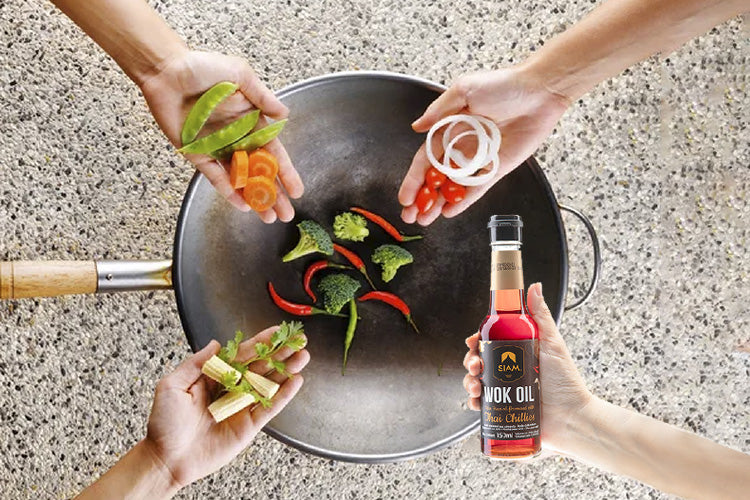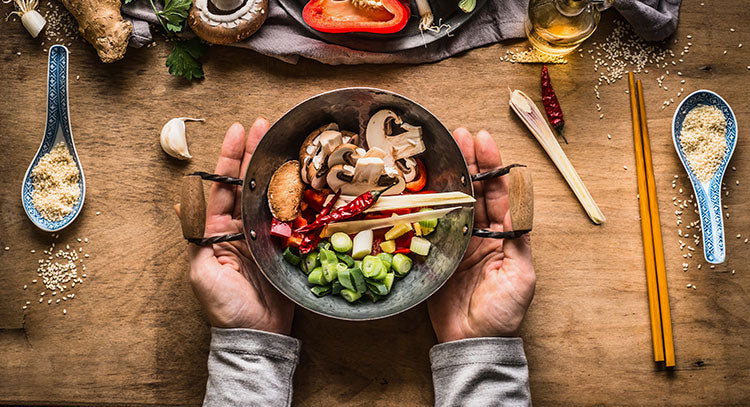My shopping cart
Your cart is currently empty.
Continue Shopping
Cooking with a wok is a great way to add variety to your meals and bring some delicious Asian-inspired flavors to your kitchen. It is a versatile cooking tool perfect for stir-frying vegetables and meats, creating soups, and even steaming dumplings.
But, before you get started, there are some things you should know to get the best results when cooking with a wok.

A wok is a traditional Chinese cooking vessel with a rounded bowl-shaped base and a long handle that allows you to move it easily over a stovetop or a heat source.
A wok is made of carbon steel or cast iron, which is perfect for stir-frying as it heats up quickly, retains heat well, and is highly durable.
An advantage of preparing food in a wok is the high, sloping walls that make it easy to stir, mix and move items around the pan without them spilling out. Cleaning the wok is also quite simple, which is why it is a favorite among Asian families.
Additionally, meals cooked in a wok that has been seasoned properly can develop a distinctive flavor and aroma, described as 'wok hei' in Cantonese.
This taste is hard to accurately describe, but some of the words used to explain it are 'smoky', ' allium-like, 'grilled', and 'metallic'.
The wok is extremely versatile and is a popular choice for cooking Chinese, Thai and Asian meals.
It can be used for stir-frying (like Pad Thai or chicken cashew nuts), deep-frying (like Thai fried pork with garlic), pan-frying, steaming, poaching, boiling, braising, searing, stewing, making soup, smoking and roasting nuts.
You can also use it to make desserts like fried rice, pancakes, and even caramel candy!

A good wok is one of the most versatile pieces of cookware you will ever own. It can be used for almost any type of Asian cooking and can even replace other pots and pans in your kitchen.
Woks can vary on everything from size, shape, and material. When buying a wok, there are a few things you can consider to get the right wok for you.
For traditional Chinese or Thai cooking, a wok made of carbon steel or cast iron is ideal because it heats up quickly, retains heat well, and is durable.
Carbon steel is the most common material due to its affordability in comparison to other options. Additionally, it being lightweight makes it simpler to handle and quicker to heat. Despite this, carbon steel woks are usually more of a challenge to season than those made of cast iron.
However, cast iron is heavy and doesn't respond to temperature changes rapidly. You can also purchase a stainless-steel wok which is good in terms of heat distribution and retention and require no seasoning, so it is ideal for people unfamiliar with woks.
However, because you cannot create a nonstick surface by seasoning, some food items may stick to the wok surface. A nonstick wok is another option for those who prefer to use less oil and need something suitable for a beginner cook since it is easy to clean and doesn’t require seasoning.
Nevertheless, because the nonstick coatings cannot be heated as high as other woks, you will not get the same sear on meats and vegetables like other woks, nor can you acquire that ideal ‘wok hei’ aroma and taste.
You may find both round and flat bottom woks on shelf and wonder which one is better. This depends on your preference and hob type.
Traditionally, woks are made with a round bottom, to enable them to be positioned near the flame. Nevertheless, due to the design of most current stoves, a wok ring or a stove with a wok top is necessary to use a regular round bottom wok.
This is why many home cooks prefer flat bottom woks which do not require any extra equipment. Although some wok experts argue that the flat bottom decreases the total surface area and makes it difficult to toss food, as compared to a round bottom wok.
Additionally, the deeper the wok is, the more food can be cooked at the same time.
Woks come with two types of handles: loop and stick. The twin loop-shaped handles are the most frequently seen and typically made of plain metal.
When a cook needs to hold the wok while tossing the food while cooking, they usually hold one of the loop handles with a thick towel. Stick handles are long, constructed out of steel and have hand grips covered with either wood or plastic.
A wok with a long handle also makes it easier for one to stir-fry food without having to be hunched over the stovetop.

A brand new wok might look pretty, but it isn't ready to be used for cooking. To make sure it's suitable for cooking, it needs to be cleaned, dried, and seasoned. Here is the process to do so:

Woks are suitable for many different cooking techniques, but the most common is stir-frying, where food is cooked in an oiled wok over a high heat, being stirred and tossed quickly.
Here are some tips and a suggested order for cooking ingredients in a wok that will help you create a delicious stir-fry dish.
Preheat the wok - heat the wok over medium-high heat and then add about 1 tablespoon of a cooking oil with a high smoke point, such as peanut oil, vegetable or Canola oil, or grapeseed oil.
The order to cook ingredients in a wok - once the wok and oil are hot, add the ingredients in the following order:
- Protein (4 to 7 minutes)
- Aromatics (1 minute)
- Vegetables (1 to 7 minutes, depending on size and sturdiness)
- Seasoning sauce or wok sauce (2 minutes)

You should also be careful about storing your wok. If it is made of carbon steel, it is best to keep it away from damp areas as this can lead to rusting.
A wok stand is a great way to keep your wok in good condition.
Additionally, it is advised to coat the inside of the wok with a teaspoon of fresh oil before storing it.